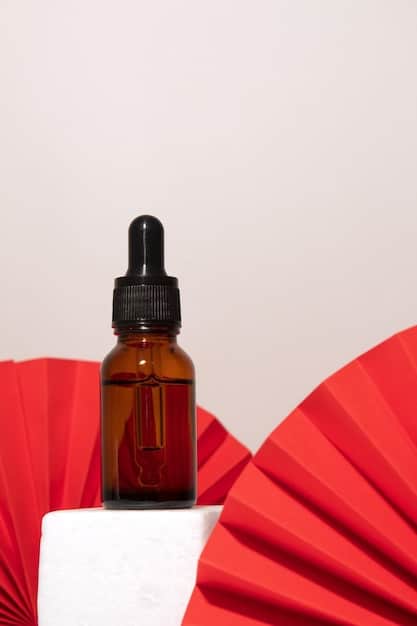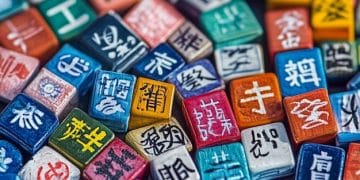Decoding Japanese Product Labels: A 2025 Guide for US Shoppers

Decoding Japanese product labels in 2025 is essential for US shoppers to avoid counterfeits, understand ingredients, and ensure product authenticity; this guide provides key insights into navigating Japanese packaging for informed purchasing decisions.
Navigating the vibrant world of Japanese products can be exciting for US shoppers, but understanding the intricate labels is crucial, especially with the rise of counterfeits; this guide shows you decoding Japanese product labels: a 2025 guide for US shoppers to avoid counterfeits, ensuring you get authentic and safe products.
Understanding the Basics of Japanese Product Labeling
Japanese product labeling can seem daunting at first glance due to the language barrier and unfamiliar symbols. However, understanding the basics can significantly enhance your shopping experience and ensure you’re purchasing genuine, safe products. This section will cover the fundamental aspects of Japanese product labels, making it easier for US shoppers to navigate them.
Key Components of a Japanese Product Label
Japanese product labels contain several key elements that provide essential information about the product. These include the product name, ingredients, manufacturer details, and usage instructions. Recognizing these components is the first step in decoding the labels.
Common Japanese Characters and Phrases
While it’s not necessary to become fluent in Japanese, learning a few common characters and phrases can be incredibly helpful. For example, 成分 (seibun) means “ingredients,” and 製造 (seizou) means “manufactured.” Familiarizing yourself with these terms will make it easier to identify crucial information.

- Product Name (製品名 or Seihinmei): This is usually written in large characters and is the most prominent part of the label.
- Ingredients (成分 or Seibun): Listed in descending order by weight, similar to US product labels.
- Manufacturer (製造者 or Seizousha): Indicates the company responsible for manufacturing the product.
- Expiration Date (消費期限 or Shohi Kigen / 賞味期限 or Shomi Kigen): Depending on the product, it will indicate either the expiration date (shohi kigen) or the best before date (shomi kigen).
By understanding these basic components and common phrases, US shoppers can start to navigate Japanese product labels more confidently, ensuring they make informed purchasing decisions.
The Importance of Recognizing Authentic Japanese Products
With the increasing popularity of Japanese products in the US market, the risk of encountering counterfeit items has also risen. Recognizing authentic products is crucial for ensuring safety, quality, and value for your money. This section will explore why it’s important to buy authentic Japanese goods and how to identify them.
Health and Safety Concerns
Counterfeit products often lack the rigorous quality control standards of authentic Japanese goods. This can lead to health and safety concerns, especially with cosmetics, food items, and pharmaceuticals. Authentic products are tested and regulated to meet safety standards, protecting consumers from harmful ingredients and manufacturing processes.
Quality and Performance
Authentic Japanese products are renowned for their high quality, durability, and performance. Counterfeit items, on the other hand, are often made with inferior materials and lack the precision engineering that characterizes genuine Japanese goods. This can result in poor performance, shorter lifespan, and overall dissatisfaction.
Supporting Ethical Manufacturing
Purchasing authentic Japanese products supports ethical manufacturing practices and fair labor standards. Counterfeit operations often exploit workers and operate in unregulated environments, undermining ethical business practices. By choosing genuine products, consumers can contribute to a more responsible and sustainable global economy.
- Check for Official Seals and Certifications: Look for recognized Japanese seals of approval that indicate the product meets specific quality and safety standards.
- Verify the Manufacturer: Research the manufacturer and confirm they are a legitimate company with a history of producing high-quality goods.
- Compare Prices: Be wary of prices that seem too good to be true, as this can be a sign of a counterfeit product.
Recognizing authentic Japanese products is essential for protecting your health, ensuring quality, and supporting ethical manufacturing practices. By taking the time to verify the authenticity of your purchases, you can enjoy the benefits of genuine Japanese goods with confidence.
Key Indicators of Counterfeit Products in 2025
As counterfeiters become more sophisticated, it’s increasingly important for US shoppers to be aware of the key indicators that can help identify fake Japanese products in 2025. This section will outline the telltale signs of counterfeit goods, enabling consumers to make informed decisions and avoid being scammed.
Packaging Discrepancies
One of the first things to look for is packaging discrepancies. Counterfeit products often have packaging that is of lower quality than authentic items. This can include misspellings, blurry printing, incorrect fonts, and flimsy materials. Always compare the packaging to images of the genuine product online.
Inconsistent Product Details
Check for inconsistencies in the product details listed on the label. Counterfeit products may have inaccurate or incomplete information, such as missing ingredients, incorrect weights or volumes, and incorrect manufacturing details. Verify the product details with the manufacturer’s official website or other reliable sources.
Unusual Pricing and Discounts
Be cautious of unusually low prices or steep discounts, especially when purchasing from unfamiliar or unverified sources. Counterfeiters often lure customers with attractive prices, but the savings come at the cost of quality and authenticity. Compare prices from multiple retailers to get a sense of the product’s typical price range.

- Poor Print Quality: Look for blurry or pixelated printing on the packaging. Authentic products have high-quality, crisp printing.
- Missing Security Features: Check for security features such as holograms, watermarks, and serial numbers.
- Strange Odors or Textures: Be wary of products that have unusual odors or textures, as this can be a sign of inferior ingredients.
By paying attention to these key indicators, US shoppers can significantly reduce their risk of purchasing counterfeit Japanese products. Staying informed and vigilant is essential for protecting yourself from scams and ensuring you get genuine, high-quality goods.
Tools and Apps for Decoding Japanese Labels
In today’s digital age, there are numerous tools and apps available to help US shoppers decode Japanese product labels quickly and easily. These resources can provide instant translations, identify ingredients, and verify product authenticity. This section will highlight some of the most useful tools and apps for navigating Japanese labels.
Translation Apps
Translation apps like Google Translate and Microsoft Translator can be invaluable for decoding Japanese labels. These apps allow you to scan the label with your smartphone camera and receive an instant translation in English. Some apps also offer offline translation capabilities, which can be useful when you don’t have internet access.
Ingredient Scanners
Ingredient scanner apps, such as Think Dirty and INCI Beauty, can help you identify and understand the ingredients listed on Japanese product labels. These apps scan the ingredient list and provide information about each ingredient, including its potential health and safety concerns. This can be particularly useful for cosmetics and personal care products.
Barcode Scanners
Barcode scanner apps can be used to verify the authenticity of Japanese products. These apps scan the barcode on the product and provide information about the manufacturer, product details, and country of origin. Some apps also allow you to check user reviews and ratings, which can help you assess the product’s quality and legitimacy.
- Google Lens: Use Google Lens to translate text in real-time by pointing your camera at the Japanese label.
- Yomiwa: A powerful Japanese dictionary app that can recognize characters and provide detailed translations.
- Japanese-English Dictionary Apps: Many dictionary apps offer comprehensive translations and cultural context for Japanese words and phrases.
By leveraging these tools and apps, US shoppers can overcome the language barrier and gain a better understanding of Japanese product labels. These resources can save you time, reduce the risk of purchasing counterfeit products, and ensure you make informed decisions.
Understanding Expiration Dates and Manufacturing Codes
One of the most critical aspects of decoding Japanese product labels is understanding the expiration dates and manufacturing codes. These codes provide essential information about the product’s freshness, shelf life, and origin. This section will guide you through the intricacies of these codes, helping you make safe and informed purchasing decisions.
Expiration Dates (消費期限 – Shohi Kigen)
Expiration dates, indicated by 消費期限 (shohi kigen), are used for perishable items like fresh food and dairy products. This date indicates the last day the product is safe to consume. It’s essential to adhere to this date to avoid health risks.
Best Before Dates (賞味期限 – Shomi Kigen)
Best before dates, indicated by 賞味期限 (shomi kigen), are used for products with a longer shelf life, such as packaged snacks and canned goods. This date indicates the period during which the product maintains its optimal quality and flavor. While the product may still be safe to consume after this date, its quality may decline.
Manufacturing Codes
Manufacturing codes are used by manufacturers for internal tracking and quality control purposes. These codes can provide information about the product’s production date, batch number, and origin. While they may not be easily deciphered by consumers, they can be useful for tracing products in the event of a recall or safety issue.
- Date Format: Japanese dates are typically written in the format Year-Month-Day (YYYY-MM-DD) or Year/Month/Day (YYYY/MM/DD).
- Look for “Lot Number” (ロット番号 – Lotto Bango): This code can help identify the specific batch the product came from.
- Contact the Manufacturer: If you have trouble understanding the codes, contact the manufacturer for clarification.
Understanding expiration dates and manufacturing codes is vital for ensuring the safety and quality of Japanese products. By paying attention to these details, US shoppers can avoid consuming expired or substandard items and make informed purchasing decisions.
Navigating Specific Product Categories: Food, Cosmetics, and Pharmaceuticals
Decoding Japanese product labels requires a nuanced approach, as different product categories have unique labeling requirements and regulations. This section will provide specific guidance for navigating labels in three common categories: food, cosmetics, and pharmaceuticals, ensuring US shoppers can make safe and informed choices.
Food Products
Japanese food labels typically include information about ingredients, nutritional values, expiration dates, and country of origin. Key terms to look for include 成分 (seibun) for ingredients, 栄養成分表示 (eiyo seibun hyoji) for nutritional information, and 原産国 (gensankoku) for country of origin. Be aware of common allergens and dietary restrictions.
Cosmetics
Cosmetic labels in Japan include information about ingredients, usage instructions, and precautions. Look for the term 全成分 (zen seibun) for a complete list of ingredients. Pay attention to any warnings about skin sensitivity or allergic reactions. Check for official seals of approval from regulatory agencies.
Pharmaceuticals
Pharmaceutical labels in Japan provide detailed information about dosage, usage instructions, precautions, and potential side effects. Key terms include 用法・用量 (yoho yoryo) for dosage and administration, 注意事項 (chui jiko) for precautions, and 副作用 (fukusayou) for side effects. Consult with a healthcare professional before using any pharmaceutical product.
- Food: Be aware of common allergens like soy, wheat, and shellfish, which are frequently used in Japanese cuisine.
- Cosmetics: Look for products that are labeled as “additive-free” (無添加 – mutenka) if you have sensitive skin.
- Pharmaceuticals: Always read the entire label and consult with a healthcare professional before using any new medication.
By understanding the specific labeling requirements for food, cosmetics, and pharmaceuticals, US shoppers can navigate Japanese product labels with confidence and make informed choices that prioritize their health and safety.
| Key Point | Brief Description |
|---|---|
| 🔍 Label Basics | Understand key components like ingredients and manufacturer. |
| 🛡️ Authentic Products | Recognize seals, verify manufacturers, and compare prices. |
| 🧐 Counterfeit Indicators | Check packaging, details, and pricing for inconsistencies. |
| 📱 Useful Tools | Use translation apps and ingredient scanners for help. |
Frequently Asked Questions
▼
Decoding Japanese product labels is critical for US shoppers to ensure product authenticity, understand ingredients for health and safety, and make informed purchasing decisions, avoiding potential scams and low-quality counterfeits.
▼
Common signs include packaging discrepancies (misspellings, poor print quality), inconsistent product details (missing ingredients), and unusual pricing (too good to be true). Always compare with official sources.
▼
Translation apps like Google Translate allow you to instantly scan and translate Japanese labels, providing quick access to ingredient lists, usage instructions, and other important product information.
▼
消費期限 (shohi kigen) indicates the expiration date for perishable items, while 賞味期限 (shomi kigen) indicates the “best before” date for items with longer shelf lives, suggesting optimal quality.
▼
Use ingredient scanner apps like Think Dirty or INCI Beauty to identify and understand ingredients, or consult official manufacturer websites for detailed product information and safety data.
Conclusion
By equipping yourself with the knowledge and tools provided in this guide, you can confidently navigate Japanese product labels and make informed purchasing decisions. Staying vigilant and understanding the key indicators of authenticity will help you avoid counterfeits and enjoy the quality and innovation of genuine Japanese products.





